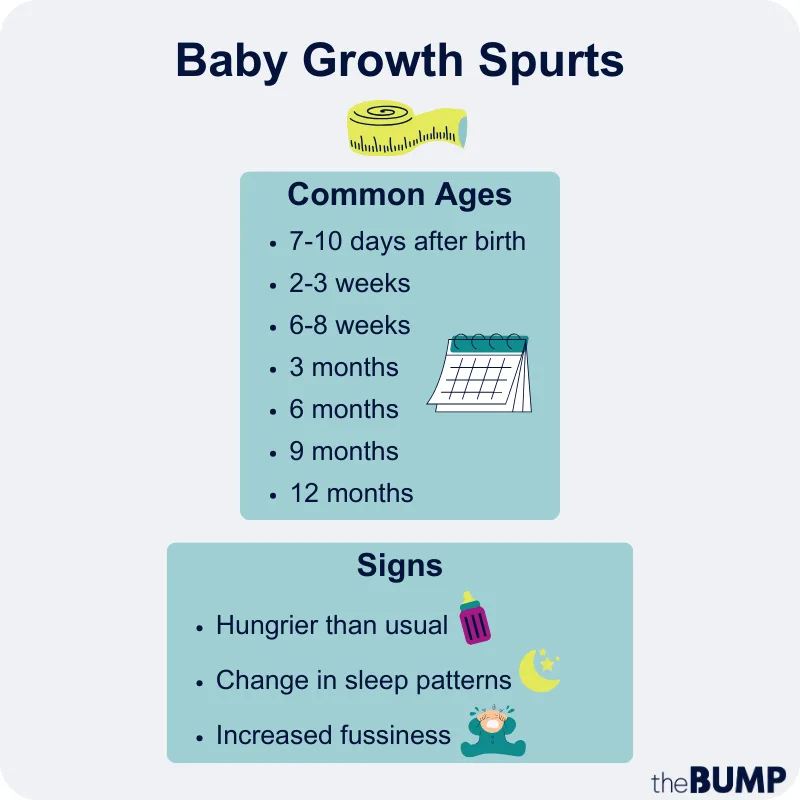What You Need to Know About Baby Growth Spurts
When it comes to raising a child, seasoned parents will tell you to expect the unexpected—and they’re totally right. Just when you start to feel like you’ve got the baby feeding and sleeping routine down pat, they suddenly become an insomniac who’s ravenous and irritable all the time. And then, just as quickly, they’ll bounce back to normal. So what gives? Chances are, you can chalk up this roller-coaster ride to baby growth spurts.
Baby’s growth during the first year of life is fast and furious. Baby growth spurts, however, are short periods of time when they really pack on the pounds and put on the inches—sometimes literally overnight. And as you can imagine, growing so quickly is tiring work. You might notice changes in baby’s sleep patterns and attitude, so it’s helpful to be able to recognize when infant growth spurts may be the culprit.
So when do babies have growth spurts? And how do you know if your little one is experiencing one? Here, experts address everything you need to know, from baby growth spurt ages to signs and symptoms, plus ways to handle these trying periods.
Before we get into the details about infant growth spurts, let’s first define what a growth spurt actually is. It refers to a period of time when baby experiences an increase in pounds and inches. Yes, your infant gradually grows and gains weight every day, but growth spurts in babies tend to be sudden and quick. During a baby growth spurt, they’ll likely want to feed more often and for longer periods to provide the necessary calories to keep up with their rapidly growing body, per Cleveland Clinic.
Wondering how growth spurts in babies relate to developmental milestones? According to Denise Scott, MD, an Oklahoma-based pediatrician, “Although an infant’s growth spurt may coincide with some developmental milestones, they usually are independent of each other.” While developmental milestones refer to the acquisition of specific skills, growth spurts refer to an increased growth rate during a short period of time.
As you track baby’s progress, you may find yourself wondering, “When do babies go through growth spurts?” While every baby is different, there’s a recognized newborn growth spurt timeline that babies tend to follow, says Lisa M. Asta, MD, a California-based pediatrician and American Academy of Pediatrics (AAP) spokesperson. The first newborn growth spurt occurs around 7 to 10 days after birth, right around the time a breastfeeding mom’s milk supply is established. Most babies finally start to put on weight, she adds.
The second happens between the three- and eight-week marks, Scott notes. After that, baby might experience more growth spurts at 3, 6, 9 and 12 months of age. Collectively, your child will likely triple their weight and grow an average of 10 inches within their first year, thanks to these baby growth spurts, Scott says. Keep in mind, however, that each child’s growth rate and timeline for growth spurts will vary.
Once you figure out when babies have growth spurts, you can begin looking for the telltale signs. These bursts may be over in the blink of an eye, but there are a few signs of a baby growth spurt you can watch for. Every child is unique and may respond differently, but here are some signals, according to the experts, you can count on to know when your little one is growing up a storm:
- Change in sleep patterns: Even if baby was once a champion sleeper, they may now be restless, have trouble falling asleep or wake at all hours of the night due to hunger, Scott says. Don’t be surprised if you notice some degree of sleep regression during baby growth spurts. Or, conversely, baby may sleep for longer stretches of time. It can go either way.
- Fussiness: Baby might be particularly irritable during the day, likely because they aren’t getting a solid stretch of sleep (and let’s face it, who isn’t cranky when they’re hungry and tired?). While baby may be fussier than usual, there’s nothing to indicate that growth spurts cause any pain. Infant growth spurts are simply a natural part of baby’s development.
- Increased hunger: Baby may be suddenly insatiable, wanting to feed around the clock—whether they’re latching onto the breast at every opportunity or feeling dissatisfied even after a full bottle. In fact, per the WIC program, breastfed babies may want to nurse for as long as 30 minutes. It’s common to see babies eat more during a growth spurt, Scott notes. “Your baby may want more volume per feeding, more frequent feedings or even want night feedings again.”
In some cases, your own body may signal that baby is going through a growth spurt: Some breastfeeding moms report feeling an uptick in hunger and thirst too. This is a sign to eat and hydrate to accommodate more frequent nursing sessions. When in doubt, listen to your body.
The good news is that newborn and baby growth spurts don’t last long. While baby will frequently undergo growth spurts throughout infancy, they’re short-lived: They usually don’t last for longer than a few days at a time, although they can sometimes stretch up to a week, Scott says. In fact, you may not even notice baby’s growth spurt until it’s over and done with, and suddenly your little one’s clothes don’t fit anymore. “They’re real, but they’re very manageable,” Asta says. “There’s nothing to fear. It’s a natural thing, and half the time you don’t even notice it.” Baby should get back to their normal sleeping and eating habits once the growth spurt subsides.
While a nice stack of wet diapers and a weight that keeps inching upward are promising signs that baby is thriving, the truest barometer of your little one’s health and wellness is the growth chart, Asta says.
Your pediatrician will measure and track baby’s height and weight during every checkup (there are plenty of them during the first 18 months) to look for patterns and trends. If baby’s growth veers sharply from their individual curve, that could be an indicator of a deeper issue, such as an illness or condition.
But you don’t have to wait for a wellness visit to talk to your doctor about baby’s growth. If you have concerns about growth spurts or any aspect of child development, discuss them with your pediatrician. “In the end, trust your gut,” Asta says. “If it seems significant, it’s worth talking to someone.”
So you think that baby might be going through a newborn growth spurt—now what? Baby will likely demand more of your attention during this phase, so be prepared to spend extra time comforting and cuddling your cutie. You’ll probably be feeding them more frequently too, so be sure to take care of yourself. Eat healthy, drink lots of water, get rest when possible and ask for help if you can.
No doubt, infant growth spurts can be hard on you. But experts recommend resisting the urge to greet all of baby’s cries with a meal, particularly if they’re past the newborn phase and were fed less than three hours ago. Asta says parents can be more liberal with feedings during the day (baby’s busy little body needs the extra fuel) but should hold off on any extra middle-of-the-night meals for older babies who don’t need them. Growth spurts in babies can negatively affect their sleep, and they need all the rest they can get. If you do choose to feed baby at night, Scott suggests offering a dream feed between 10 pm and midnight to prevent disturbing baby’s sleep.
That said, more frequent feedings can also increase your milk supply, which helps provide for your extra-hungry growing baby. Soothing with food can lead to overfeeding though, so before you brandish a bottle or breast, look for basic hunger cues, like rooting around for the breast or bottle, and respond accordingly, says Ian M. Paul, MD, head of general pediatrics at Penn State Children’s Hospital. “When babies turn their heads away from the breast or bottle, it means they’re done, yet some parents continue to try to get them to finish the bottle,” he says. Instead, follow baby’s hunger cues.
Other methods of soothing older babies at night include changing their diaper, re-swaddling them, putting on white noise or singing to them, Paul says. “You can do other things to try to get baby to settle down without necessarily feeding them.”
Equal doses of patience and perspective can come in handy when your little one isn’t easily consoled during a newborn or infant growth spurt. They may be hard on you, but hang in there—after all, baby growth spurts are signs that baby’s growth is right on track.
Frequently Asked Questions
How quickly do babies grow?
According to the Mayo Clinic, the average baby can grow one inch every month in the first six months and around half an inch each month during the next six months. In fact, baby will be roughly half their adult height by 2 years old and have doubled their birth length by 4 years old, Scott says.
In terms of baby’s weight, Mayo Clinic notes they’ll gain 5 to 7 ounces every week in the first six months. (Newborn boys tend to weigh slightly more than newborn girls and are longer by roughly half an inch.) They’ll double their birth weight by the four- to six-month mark and triple in weight by the time their first birthday rolls around, Scott says. They’ll quadruple their birth weight between 24 and 30 months.
Should baby eat more during a growth spurt?
Each child will be different, and some may want to eat more than others during a baby growth spurt. However, it is common to see babies eat more during this time, Scott says. Offer extra feeds during the day and speak to your pediatrician about offering them at night. Most importantly, follow baby’s hunger cues—if baby is hungrier than normal during a growth spurt, they’ll give you signs.
Do babies sleep more during growth spurts?
While rapidly growing babies do need more sleep, this will vary from baby to baby, Scott notes. “They may want to nap more during the day, however, they also may wake more at night because they’re hungry.”
What are growth spurt ages for toddlers?
“Interestingly, an infant is on an overall slowing trend in their growth once they exit the womb until toddlerhood,” Scott says. “They grow most rapidly during their first six months.” Toddlers on the other hand, experience more consistent growth with minimal growth spurts. In fact, the next series of big growth spurts usually occurs at puberty, she adds.
While baby’s growth spurt may come as a shock at first, remember, it’s all part of baby’s natural progress and development. Nothing is more special than watching your child grow and get stronger right before your eyes. Now that you have a better idea of when babies have growth spurts, you’ll know what to look for and how to handle them. Remember, this exhausting phase will pass.
Please note: The Bump and the materials and information it contains are not intended to, and do not constitute, medical or other health advice or diagnosis and should not be used as such. You should always consult with a qualified physician or health professional about your specific circumstances.
Plus, more from The Bump:
Lisa M. Asta, MD, is a board-certified pediatrician with Marin Community Clinics in California. She obtained her bachelor’s degree from Johns Hopkins University, received her medical degree from Temple University School of Medicine and completed her residency at St. Christopher’s Hospital for Children in Philadelphia. She is also a clinical professor of pediatrics at the University of California at San Francisco and a fellow of the American Academy of Pediatrics.
Ian M. Paul, MD, MSc, is the chief of division of academic general pediatrics at Penn State Health Children’s Hospital, as well as the university professor of pediatrics and public health sciences at Penn State College of Medicine. He earned his medical degree from Penn State College of Medicine and completed his residency in pediatrics at Duke University.
Denise Scott, MD, is a pediatrician with JustAnswer and a pediatric endocrinologist based in Oklahoma with over 30 years of experience. Certified in culinary medicine, Scott also runs the blog Feed Future Health and is the author of Feed Your Child's Future Health: Prevent Disease Before it Starts. She received her medical degree from the University of Texas Medical Branch and completed her residency at the University of Oklahoma Health Sciences Center with a fellowship at the National Institutes of Health.
Cleveland Clinic, Growth Spurts & Baby Growth Spurts, November 2021
Mayo Clinic, How much should I expect my baby to grow in the first year?, January 2023
Learn how we ensure the accuracy of our content through our editorial and medical review process.
Navigate forward to interact with the calendar and select a date. Press the question mark key to get the keyboard shortcuts for changing dates.





















































